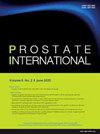Efficacy of tamsulosin 0.4 mg for the treatment in male with the international Prostate Symptom Score ≥ 20 compared with tamsulosin 0.2 mg
IF 2.6
2区 医学
Q2 UROLOGY & NEPHROLOGY
引用次数: 0
Abstract
Purpose
Tamsulosin 0.2 mg is commonly used as the start dose for Asian benign prostatic hyperplasia (BPH) patients, while the 0.4 mg is recommended for Western countries. Recent studies reported that efficacy and safety of tamsulosin 0.4 mg is superior to that of tamsulosin 0.2 mg. However, there is a lack of evidence about the efficacy of tamsulosin 0.4 mg for a long time follow-up and focused on BPH patients who complained of severe International Prostate Symptom Scores (IPSSs). This study aimed to evaluate the efficacy of tamsulosin 0.4 mg compared with tamsulosin 0.2 mg in Korean BPH patients with severe IPSSs.
Materials and methods
We reviewed data from 13,115 men treated with tamsulosin for symptomatic lower urinary tract symptoms (LUTS) between January 2015 and June 2020. A total of 2,280 participants with a baseline total IPSS ≥20 who completed 4, 12, and 24-week follow-up IPSS and uroflowmetry (UFM) assessments without changing their initial tamsulosin dose were included. The participants were divided into two groups: Group 1 treated with tamsulosin 0.4 mg and Group 2 treated with tamsulosin 0.2 mg. The primary objective of the present study was to prove the superiority of tamsulosin 0.4 mg to 0.2 mg for improvement in total IPSS score and also prove it in IPSS subscores and UFM.
Results
Total IPSS for Group 1 (n = 984) had a significant decrease at four weeks compared with Group 2 (n = 1,296) (P = 0.027), and the obstructive subscore decreased more at 12 weeks in Group 1 than in Group 2 (P = 0.042). At four weeks, the maximum urinary flow rate (Qmax) significantly improved in Group 1 compared with Group 2 (P < 0.011). However, there were no significant efficacy differences between the groups at 24 weeks.
Conclusion
This study demonstrates the potential superiority of tamsulosin 0.4 mg in improving IPSS and UFM parameters in Korean BPH patients with severe IPSS during the short-term follow-up. However, long-term efficacy requires further investigation.
坦索罗辛0.4 mg与坦索罗辛0.2 mg治疗国际前列腺症状评分≥20的男性的疗效比较
目的:亚洲良性前列腺增生(BPH)患者通常使用0.2 mg的坦舒洛辛作为起始剂量,而西方国家推荐使用0.4 mg。最近的研究报道,0.4 mg的坦索罗辛的疗效和安全性优于0.2 mg的坦索罗辛。然而,缺乏关于0.4 mg坦索罗辛的长期随访疗效的证据,并侧重于抱怨严重国际前列腺症状评分(ipss)的BPH患者。本研究旨在评价坦索罗辛0.4 mg与坦索罗辛0.2 mg在韩国BPH合并重度ipss患者中的疗效。材料和方法我们回顾了2015年1月至2020年6月期间接受坦索罗辛治疗症状性下尿路症状(LUTS)的13115名男性的数据。在不改变初始坦索罗辛剂量的情况下,共有2,280名基线总IPSS≥20的参与者完成了4,12和24周的IPSS和尿流法(UFM)随访评估。将受试者分为两组:1组给予坦索罗辛0.4 mg, 2组给予坦索罗辛0.2 mg。本研究的主要目的是证明0.4 mg坦索罗辛优于0.2 mg坦索罗辛对IPSS总评分的改善,以及对IPSS亚评分和UFM的改善。结果1组(n = 984)的总IPSS在4周时较2组(n = 1296)显著降低(P = 0.027), 12周时1组的阻塞性评分下降幅度大于2组(P = 0.042)。第4周时,组1最大尿流率(Qmax)较组2显著提高(P < 0.011)。然而,在24周时,两组疗效无显著差异。结论在短期随访中,坦索罗辛0.4 mg在改善韩国BPH合并重度IPSS患者的IPSS和UFM参数方面具有潜在优势。然而,长期疗效需要进一步研究。
本文章由计算机程序翻译,如有差异,请以英文原文为准。
求助全文
约1分钟内获得全文
求助全文
来源期刊

Prostate International
Medicine-Urology
CiteScore
4.40
自引率
26.70%
发文量
40
审稿时长
35 days
期刊介绍:
Prostate International (Prostate Int, PI), the official English-language journal of Asian Pacific Prostate Society (APPS), is an international peer-reviewed academic journal dedicated to basic and clinical studies on prostate cancer, benign prostatic hyperplasia, prostatitis, and ...
 求助内容:
求助内容: 应助结果提醒方式:
应助结果提醒方式:


